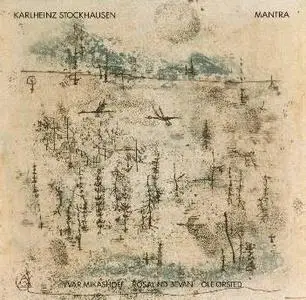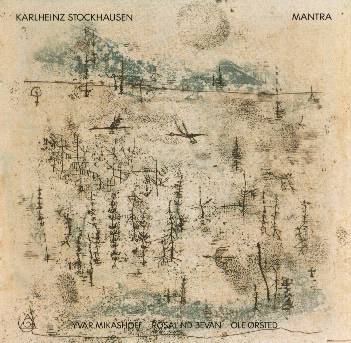Karlheinz Stockhausen: Mantra
Classical | EAC (APE & CUE) | New Albion (1990) | 2 parts / 179 MB
Classical | EAC (APE & CUE) | New Albion (1990) | 2 parts / 179 MB
"With its exotic, gamelan like timbres (the result of electronic processing) and its deft balance of meditative stasis and kinetic repetition, Mantra is one 60's piece that has survived its era." ―The New York Times
Karlheinz Stockhausen (1928 - )
Mantra (NA025 CD)
Yvar Mikhashoff, Rosalind Bevan (piano) & Ole Ørsted (electronics)
Recorded January 1986 at the Sonja Henie-Niels Onstad Museum, Oslo, Norway.
Track List
1. 00'00" (2:10)
2. 02'15" (4:37)
3. 06'38" (4:51)
4. 11'38" (5:35)
5. 17'23" (2:52)
6. 20'00" (4:39)
7. 24'44" (5:05)
8. 29'53" (4:21)
9. 34'15" (3:36)
10. 37'50" (4:43)
11. 42'40" (4:44)
12. 47'10" (6:04)
13. 53'20" (3:16)
14. 56'33" (3:25)
15. 60'15" (5:24)
16. 65'20" (3:19)
17. 69'30" (0:55)
Total: 69:30
At its premiere, Mantra seemed rather exalted and exotic with the piano sound broken down by ringmodulators, as if it were a late version of "Amores" or "Sonatas and Interludes" by John Cage, rich with figures, flamboyant. Dating from 1971, Mantra shows how Stockhausen went from pure sound to iconoclastic usages of more traditional instruments (in this case, two pianos), but combined with electronics and non-musical instruments (a short-wave radio) to yield a startling and yet new form that is both abstract and inviting. However, it also suggests a synthetic and systematic preparation of the pianos, that seemed to be an artificial additive compared to the concrete preparations done by Cage. Mantra really seemed to be independent of its contemporaries, like the student movement, untouched and reaching behind, into the spirit of what one later, in postmodern language, might call "Zeitgeist."
Download
(Updated!)
(Updated!)



